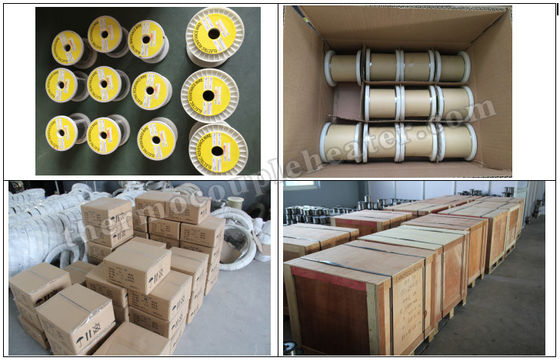Thermocouple Alloy Wire
1. Thermocouple Alloy Wire Brief Introduction
Thermocouples are widely used within industry as a method of measuring temperature and the Thermocouple Wire is the means to transfer the measurement from the source to the recording instruments.
The principle of joining two different metals to create a voltage is the basis for all thermocouples and we manufacture the major Types and Grades to meet the wide range of applications from small measuring instruments to heavy chemical and power generation plants.
2. Thermocouple Alloy Wire Parameter.


3. How To Choose Thermocouple Alloy Wire
Thermocouple wire, thermocouple bare wire type k
1) Type K (Chromel / Alumel)
Type K is the ‘general purpose’ thermocouple. It is low cost and, owing to its popularity, it is available in a wide variety of probes. Thermocouples are available in the -200 °C to +1200 °C range. Sensitivity is approx 41 µV/°C. Use type K unless you have a good reason not to.
2) Type E (Chromel / Constantan)
Type E has a high output (68 µV/°C) which makes it well suited to low temperature (cryogenic) use. Another property is that it is non–magnetic.
3) Type J (Iron / Constantan)
Limited range (-40 to +750 °C) makes type J less popular than type K. The main application is with old equipment that can not accept ‘modern’ thermocouples. J types should not be used above 760 °C as an abrupt magnetic transformation will cause permanent decalibration.
4) Type N (Nicrosil / Nisil)
High stability and resistance to high temperature oxidation makes type N suitable for high temperature measurements without the cost of platinum (B,R,S) types. Designed to be an ‘improved’ type K, it is becoming more popular.
Thermocouple wire, platinum wire
1) Thermocouple types B, R and S are all 'noble' metal thermocouples and exhibit similar characteristics. They are the most stable of all thermocouples, but due to their low sensitivity (approx 10 µV/°C) they are usually only used for high temperature measurement (>300 °C).
2) Type B (Platinum / Rhodium)
Suited for high temperature measurements up to 1800 °C. Unusually type B thermocouples (due to the shape of theirtemperature / voltage curve) give the same output at 0 °C and 42 °C. This makes them useless below 50 °C.
3) Type R (Platinum / Rhodium)
Suited for high temperature measurements up to 1600 °C. Low sensitivity (10 µV/°C) and high cost makes them unsuitable for general purpose use.
4) Type S (Platinum / Rhodium)
Suited for high temperature measurements up to 1600 °C. Low sensitivity (10 µV/°C) and high cost makes them unsuitable for general purpose use. Due to its high stability type S is used as the standard of calibration for the melting point of gold (1064.43°C).
When selecting thermocouple types, ensure that your measuring equipment does not limit the range of temperatures that can be measured. Listed below is the range of temperatures that the 8 channel Pico TC-08 can measure.
4. Packing Information

5. Transportation


 Your message must be between 20-3,000 characters!
Your message must be between 20-3,000 characters! Please check your E-mail!
Please check your E-mail!  Your message must be between 20-3,000 characters!
Your message must be between 20-3,000 characters! Please check your E-mail!
Please check your E-mail! 





